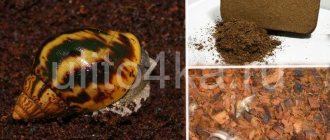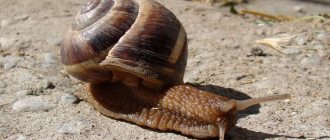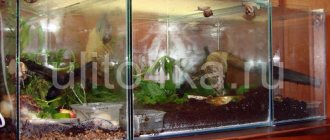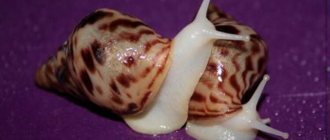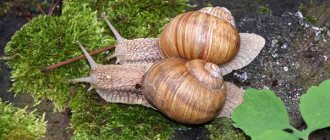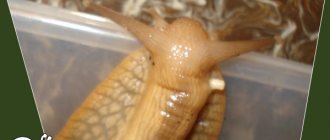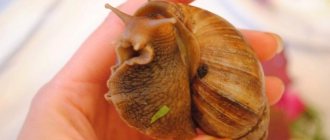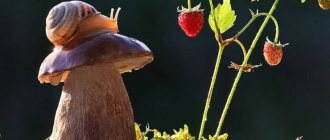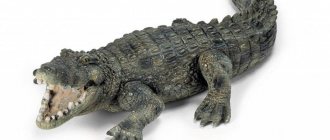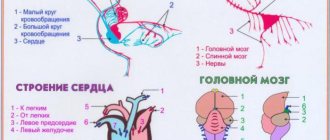In the process of evolution, vision, as a way of perceiving light, is found in the simplest single-celled organisms. This is a photosensitive red eye in the alga Chlamydomonas and in the flagellate representative Euglena green.
The organs of vision in gastropods develop from special invaginations of the integument.
In multicellular organisms, the function of determining light becomes more complicated. It is easier to get food in the light, and in the dark it is easier to hide from enemies. Cells sensitive to light form groups - pigment clusters, which can be considered the first primitive organs of vision. Pigment pits allow organisms to respond to light and navigate their environment. From the pit a special chamber was formed, which worms and primitive mollusks still have.
The pigment spot not only detects light, but also records the direction of sunlight. Gastropods have acquired light-sensitive cells that hide in recesses. The eyes have become a three-dimensional structure, which makes it easier to determine the light source, and instead of a pigment spot, a pit with pigments has formed.
There is a lens in the cavity - this is a lens shaped like a sphere.
Different groups of soft-bodied animals have preserved to the present day transitional forms from the pigment spot in snails to the visual chamber of the nautilus and to the complex eyes of octopuses, similar to human eyes.
Answers for young owners - do snails have teeth, legs and eyes?
In addition to the ordinary street snails that our grandparents kept at home when they were little, exotic mollusks from Africa have now become extremely popular. Breeders provide melancholy beauties with cozy places in their apartments and country houses. Many owners not only admire the beautiful Achatina, but also breed babies for sale. Beginning breeders who are just studying African individuals often ask, where are the snail’s eyes and do Achatina snails have teeth? These and other interesting questions are answered by experienced zoologists with many years of experience.
Read more about the structure of the Achatina snail in our article.
Benefits of Achatina
This African inhabitant is recommended as a pet for very busy people. They will not require a lot of time, like most birds or four-legged animals:
- practically does not require maintenance;
- no need to walk;
- no need to visit a veterinarian;
- quiet pet;
- eats little.
The snail does not make noise, does not wake you up in the morning, and does not demand food with loud cries. It does not damage the furniture and personal belongings of the owner, does not cause an allergic reaction, and does not smell. This number of advantages makes Achatina an excellent option even for allergy sufferers. In addition, scientists believe that these snails can relieve stress.
Snail teeth
On thematic forums you can often find messages that baby Achatina have gnawed on their shells. Breeders are surprised how sharp the teeth of snails are, that they manage to destroy the strong shells of their neighbors?
How many teeth does a snail have? – 25 thousand in one language – radula. It works like a grater.
For the information of young owners, the teeth of different animal species are arranged differently and are divided into certain groups. The cute creatures of Achatina can eat rough leaves and scrape small particles from chalk pieces. Upon closer inspection, it may seem that the mollusks are toothless, but their love of eating tough plants suggests otherwise. So does a snail have teeth and what are they for?
Interesting fact! Many consider the shark to be the most toothy animal on the planet, but in fact, the first place in this ranking is occupied by an ordinary grape hive!
Probably no one has ever looked into the mouth of a pet with a magnifying glass. Only based on data from a zoologist, we can say that the number of teeth in a snail reaches tens of thousands, and they are located on the tongue. It turns out that the tiny tongue of the snail resembles a fine grater, with the help of which Achatina scrapes and grinds food. The chitinous teeth of the snail have the same appearance and are not divided into groups. It is important to remember that the digestion of mollusks is adapted to digesting only small particles, and any large pieces can damage the tongue and kill even a large adult specimen.
Attention to novice breeders! Small teeth are not designed for biting, and if individuals attack each other to gnaw on the shell, then the pets have obvious problems with calcium balance. How many teeth a snail has, the number of small cuts it can inflict on its weaker neighbor. Predatory mollusks use their grater to “drill” a hole in the oyster shell and completely eat its tender meat!
Origin of the species and description
Photo: Achatina snail
Achatina or gastropod, belonging to the order of pulmonate snails, suborder of stalked-eyes, family of Achatna. The first gastropods inhabited our planet from the beginning of the Cretaceous period of the Mesozoic era. The oldest gastropod fossils are almost 99 million years old. The ancestors of gastropods were the ancient ammonite mollusks, which existed from the Devonian period to the Cretaceous period of the Mesozoic era.
Video: Achatina snail
Ammonites were very different from modern snails. Ancient snails were predatory and more similar to modern molluscs Nautilus pompilius. These mollusks swam freely in the water and were of enormous size. The species Achatina fulica was first described by the French zoologist Baron André Etienne Ferussac in 1821.
Achatina are a whole group of land snails which includes such species as:
- achatina reticulata;
- achatina Craveni;
- achatina glutinosa;
- achatina immaculata;
- achatina Panthera;
- achatina Tincta;
Achatina are large snails with a long shell of 8-15 cm, however, there are also very large specimens whose shell size is more than 25 cm. The snails have a canonical-shaped shell, twisted counterclockwise. On average there are about 8 turns on a shell. The color of a snail can vary and depends on what the snail eats. Basically, yellow and brown tones predominate in the color of Achatina. The shell often has a pattern of yellow and red-brown stripes.
Let's look into the eyes of Achatina
In funny cartoons, Achatina eyes are drawn on long thin horns. Many breeders are of the opinion that the organs of vision of mollusks are located at the base of the antennae. But this is an erroneous opinion, and the time has come to figure out where Achatina’s eyes are?
It is known for sure that gastropods have poor vision and can only see objects at a distance of a few centimeters.
Mollusks perfectly distinguish between light and darkness and can react to bright flashes not only with their eyes, but with their whole body. Experienced owners leave part of the aquarium in the shade when installing lighting. With a constant stream of bright light, the hives will constantly bury themselves in the ground and hide from external stimuli.
In cartoons, the head of a snail is correctly depicted; the eyes of the mollusks are located on thin horns and are almost invisible. On the head of the Achatina snail, where the eyes are concentrated, thousands of light-sensitive cells are concentrated. They form the lens, which is attached to the optic nerves. Babies have a limited angle of vision, and moving eye barrels help them better see various interesting objects.
General provisions
2.1. Use of the Otmetka website by the User means acceptance of this Privacy Policy and the terms of processing of the User’s personal data.
2.2. In case of disagreement with the terms of the Privacy Policy, the User must stop using the Otmetka website.
2.3. This Privacy Policy applies to the Otmetka website. The review site does not control and is not responsible for third party sites that the User can access via links available on the Otmetka website.
2.4. The Administration does not verify the accuracy of the personal data provided by the User.
Where hasn't a snail gone before?
From zoology lessons we know that the delicate body of a mollusk is hidden in a protective shell. All the vital organs are hidden in the shell, and only the funny snail’s head and flat belly peek out from the house.
Achatina crawls slowly, smoothly and very impressively. Young mollusk fishermen often ask how many legs does a snail have? This question can be safely answered – one.
The abdomen, with the help of which the exotic beauty moves along the ground, is called the snail’s leg. Alternate muscle contraction leads to wave-like movement of the sole. The mucus secreted by the individual facilitates gliding and reduces friction of the snail's leg on various rough surfaces. If you conduct an experiment and run a clam along the blade of a knife, it will not get hurt, but will gently envelop it.
How many legs does a snail have? To answer this question, you can send your pet on a journey through transparent glass. On the reverse side, you will see how the muscles of the flat stalk contract, and the mollusk strives to explore a new unknown space.
The snail's foot has completely unique properties. She can overcome any surface without harming herself. Extreme experimenters tested what would happen if a snail was hit by a blade.
Protective functions of the sink
The snail shell, quite strong and massive, performs the following functions:
- protects the soft body from mechanical damage during movement;
- protects from potential enemies;
- protects the snail's body from drying out.
The structure of the snail, or rather its shell, is directly influenced by the climatic conditions in which it lives. Thus, at high humidity the shell is thin and transparent; in dry and hot climates, its walls become thicker and the color becomes white (reflects the sun's rays and protects the snail from overheating).
Additional terms
9.1. The Administration has the right to make changes to this Privacy Policy without the User’s consent.
9.2. The new Privacy Policy comes into force from the moment it is posted on the Otmetka website, unless otherwise provided by the new edition of the Privacy Policy.
9.3. Any suggestions or questions regarding this Privacy Policy should be addressed to:
Source of the article: https://otmetka.tv/%D0%B1%D0%B5%D0%B7-%D1%80%D1%83%D0%B1%D1%80%D0%B8%D0%BA%D0 %B8/zachem-ulitke-nuzhny-usiki
Reproduction
Like all pulmonary gastropods, Achatina are hermaphrodites; they combine the qualities of female and male individuals. Reproduction occurs when one or more individuals are present. Fecundity is very high - several hundred eggs (up to 600) are separated from one organism per approach, and quickly develop independently.
Self-fertilization occurs within the individual, but mating stimulates this process. The mollusks press their soles tightly against each other and shoot special needles into the partner’s body - “arrows of love.” Sperm can be stored in the body of Achatina for years. Some varieties do not lay eggs, carry them for a long time and release them either closer to maturity or at the time of hatching.
Snails reproduce if the environment is warm enough and there is something to eat. A person will most likely need to independently regulate the number of eggs, destroying most of them, since mollusks reproduce very quickly.
Eggs are laid deep in the ground. The young hatch in 4 to 30 days. They initially feed on their own shell and yolk sac. Then, slowly rising to the surface, with the substrate. Complementary feeding should begin with calcekashi.
Subject of the privacy policy
3.1. This Privacy Policy establishes the Administration’s obligations to non-disclose and ensure a regime for protecting the confidentiality of personal data that the User provides at the Administration’s request when registering on the Otmetka website or when subscribing to the e-mail newsletter.
3.2. Personal data permitted for processing under this Privacy Policy is provided by the User by filling out forms on the Otmetka website and includes the following information: 3.2.1. last name, first name, patronymic of the User; 3.2.2. User's contact phone number; 3.2.3. email address (e-mail) 3.2.4. place of residence of the User (if necessary) 3.2.5. photo (if necessary)
3.3. The review site protects Data that is automatically transmitted when visiting pages: – IP address; – information from cookies; – information about the browser – access time; – referrer (address of the previous page).
3.3.1. Disabling cookies may result in the inability to access parts of the site that require authorization.
3.3.2. The review site collects statistics about the IP addresses of its visitors. This information is used to prevent, identify and resolve technical problems.
3.4. Any other personal information not specified above (visit history, browsers used, operating systems, etc.) is subject to secure storage and non-distribution, except for the cases provided for in paragraphs. 5.2. of this Privacy Policy.
Purposes for collecting user personal information
4.1. The Administration may use the User’s personal data for the following purposes: 4.1.1. Identification of the User registered on the Otmetka website for his further authorization. 4.1.2. Providing the User with access to personalized data from the Otmetka website. 4.1.3. Establishing feedback with the User, including sending notifications, requests regarding the use of the Otmetka website, processing requests and applications from the User. 4.1.4. Determining the location of the User to ensure security and prevent fraud. 4.1.5. Confirmation of the accuracy and completeness of personal data provided by the User. 4.1.6. Creating an account to use parts of the Otmetka website, if the User has agreed to create an account. 4.1.7. Notifications to the User by email. 4.1.8. Providing the User with effective technical support if problems arise when using the Otmetka website. 4.1.9. Providing the User, with his consent, with special offers, newsletters and other information on behalf of the Otmetka website.
It is a sought after food source for many predators
Snails are an important food source for wildlife and people (they are eaten throughout the world as a delicacy). Aquatic individuals are preyed upon by predatory fish, crayfish, leeches and giant water bugs. For terrestrial individuals, mammals, birds and some types of insects pose a danger.
Snails are also kept as pets, but they are usually classified as pests (due to their ability to destroy garden plants and crops).
Responsibility of the parties
7.1. The Administration, which has not fulfilled its obligations, is responsible for losses incurred by the User in connection with the unlawful use of personal data, in accordance with the legislation of the Russian Federation, except for the cases provided for in paragraphs. 5.2. and 7.2. of this Privacy Policy.
7.2. In case of loss or disclosure of Confidential Information, the Administration is not responsible if this confidential information: 7.2.1. Became public domain until it was lost or disclosed. 7.2.2. Was received from a third party before it was received by the Resource Administration. 7.2.3. Was disclosed with the consent of the User.
7.3. The user bears full responsibility for compliance with the requirements of the legislation of the Russian Federation, including laws on advertising, on the protection of copyright and related rights, on the protection of trademarks and service marks, but not limited to the above, including full responsibility for the content and form of materials.
7.4. The user acknowledges that responsibility for any information (including, but not limited to: data files, texts, etc.) to which he may have access as part of the Otmetka website lies with the person who provided such information.
7.5. The User agrees that the information provided to him as part of the Otmetka website may be an object of intellectual property, the rights to which are protected and owned by other Users, partners or advertisers who post such information on the Otmetka website. The User may not modify, rent, loan, sell, distribute or create derivative works based on such Content (in whole or in part), unless such actions have been expressly authorized in writing by the owners of such Content in accordance with terms of a separate agreement.
7.6. In relation to text materials (articles, publications that are freely available to the public on the Otmetka website), their distribution is permitted provided that a link to the Review Site is provided.
7.7. The Administration is not liable to the User for any loss or damage incurred by the User as a result of the deletion, failure or inability to save any Content and other communication data contained on the Otmetka website or transmitted through it.
7.8. The administration is not responsible for any direct or indirect losses resulting from: the use or inability to use the site or individual services; unauthorized access to the User's communications; statements or conduct of any third party on the Site.
7.9. The administration is not responsible for any information posted by the user on the Otmetka website, including, but not limited to: information protected by copyright, without the express consent of the copyright owner.
